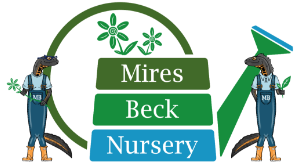Woodland
Posted on 27th July 2020 at 08:00
Woodland
Woodland Walk
Our Woodland is young having only had 30 years so far to mature and there is still a lot of new undergrowth being planted this year as part of the ongoing management. Thanks to funding from various supporters, this year we have also planted another 2000 trees to help balance the various tree species needed to provide habitat for wildlife and help the wood self seed. It is quite magical with a meandering walk where the service users are able to listen and spot the birds nesting here and around the local waters. Our teams learn about tree health and about the bugs which feed in the undergrowth and we have activities on public event open days for people to learn from the fact sheets. We train our service users about the variety of trees and what fruits for wildlife they produce.
Habitat
Our Woodland is the ideal home for all the wildlife that choose to stay here at Mires Beck Nursery. Whenever we fell a tree, we will create habitat piles which creates nesting sites for mammals to grow and feed their young. Some of our trees that we plant in the woodland are an excellent food source, with trees growing fruits such as: Rowan berries, Guelder Rose, Hawthorn, and many more. When all the fruit is gone, the birds need to find habitat and food in order to survive. Due to global warming, trees are producing fruit quicker than in the past years which results in there being no food left for autumn/winter. This means that we need to help take care of our birds by feeding them and creating places where they can stay in order to survive during the colder months.
Due to us providing a habitat for the wildlife here, we are fortunate to have seen many different species of creatures. For example, the birds that are often seen in our woodland vary between: blue tit, great tit, long tail tit, goldfinch, green woodpecker, tree creeper, hedge sparrow, house sparrow, greater spotted woodpecker, robin, wren, as well as many more.
Our charity is situated next door to the North Cave wetlands which means we get lots of wildlife visiting our site. Our site accommodates for all wildlife include wetland creatures. We are currently linking the woodland which will help create more habitat for these wetland wildlife. We have a pond that has become a home to many wildlife such as: toads, newts, dragonfly's, damselflies and more. In addition our woodland is home to wildlife such as: birds, foxes, squirrels mice, rabbis, deer etc.
The Great Crested Newt (as seen in our logo) is a protect species under the Wildlife and Countryside Act. They spend half of their time in water, and the other half on ground. We are proud to know that we hold these protected species due to us having the pond and woodland which makes our site their paradise.

Beyond the Rabbit-Proof Fencing
In our grounds care team, their work is very varied. The team maintain the 14-acre rural horticultural site and carry out all the countryside management our nursery, meadows and woodland require. This is a huge undertaking of mowing meadows, planting wildflowers throughout the woods and managing the planting of young trees. From splitting giant logs and clearing pathways in the woods, to felling trees for conservation or to fuel our log burners. They support the conservation aims and help with developing the projects around the site. The team maintains our rabbit proof boundaries and general fencing requirements as well as general path maintenance around the nursery. Access to the site is also maintained by the team who regularly manage the vital work to the rural approach road for all traffic into the nursery.
Future Projects
Here at Mires Beck Nursery, we are always thinking of new things to bring to our site that will benefit everyone. We currently have a few projects that we would like to have completed by 2022. These projects being: building a tree house, building a log store to chop all the logs that we use, create a children’s play area in the woodland, plant more trees. Planting trees is something that we always do here however, it is very important for the grounds care team as they will chop down some of our trees. We will always plant a new tree to replace the tree that has been cut down.
For 2020 we are building a bird watching station as it helps to bring academic and life skills into one activity that can be re-visited year-round, at any time of the day. Bird watching is great especially for children as they may learn how to: observe and record data, pay close attention to detail, compare, use reference materials to identify species, discuss findings with others. As well as helping children, a new study has found that bird watching can have a positive effect on mental health. Researchers have found that people who can watch birds from their homes have a lower risk for depression, stress, and anxiety compared to people who live in less leafy areas with fewer birds.

Tagged as: Blog
Share this post:

